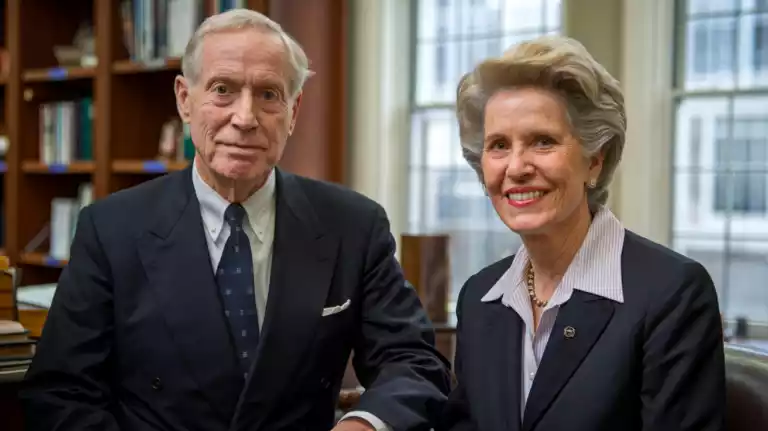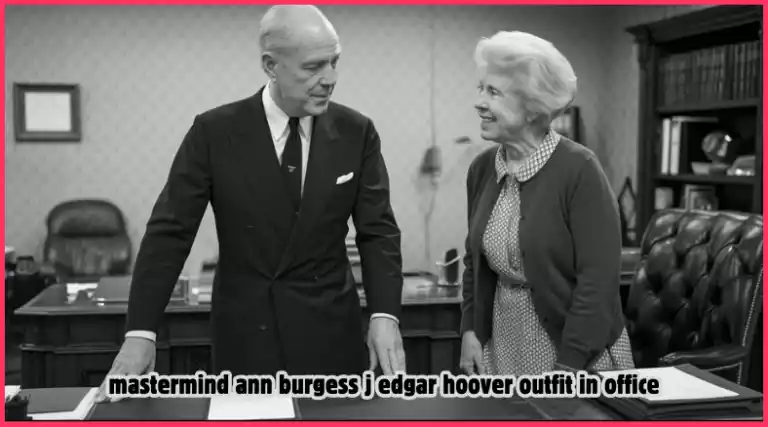The intersection between clothing, power, and perception has long been a subject of interest, particularly when examining historicalfigures like J. Edgar Hoover and modern psychologicalconcepts from experts like Ann Burgess.
Hoover, as the first Director of the Federal Bureau of Investigation (FBI), was known not just for his authoritative leadership but also for his meticulous attire. Similarly, Ann Burgess, apioneer in forensic psychology, explored how external cues such as clothing provide insight into an individual’s psychological makeup, behaviors, and leadership potential.
In this article, we will explore the fascinating connection between Mastermind Ann Burgess J. Edgar Hoover Outfit in Office, delving into the significance of Hoover’s clothing choices and how they aligned with Burgess’ understanding of human behavior. We’ll examine how Hoover’s outfits were not merely about fashion but were strategic decisions that reinforced his power and authority. Furthermore, we will discuss how these decisions fit into Burgess’ broader theories about attire and the subconscious psychological messages clothing sends.

The Mastermind: J. Edgar Hoover and His Iconic Office Attire
J. Edgar Hoover led the FBI from 1924 to 1972, serving in a period of immense social, political, and cultural change in America. During his long tenure, Hoover was not only a powerful law enforcement figure but also a man whose image was carefully cultivated. His office attire played a crucial role in projecting the authority and control that defined his leadership style.
The Power of Attire: Hoover’s Signature Style
Hoover’s wardrobe was famously consistent, characterized by dark, tailored suits, crisp white shirts, and polished shoes. His attire was not simply a reflection of fashion trends but a strategic tool that symbolized his authority. In fact, Hoover’s clothing choices were as much a part of his leadership strategy as his policies and decisions.
His dark suits conveyed seriousness, discipline, and professionalism, reinforcing the image of an unyielding leader. When Hoover walked into a room, his suit was a symbol of power, order, and control. For Hoover, every detail of his outfit, from the cut of his suit to the shine of his shoes, was meticulously chosen to reinforce his image as a leader who demanded respect.
Hoover’s Outfit as a Visual Representation of Authority
Hoover’s use of clothing was deliberate. His dark, tailored suits acted as visual tools to reinforce his leadership style. These choices were especially significant in a time when public perception of authority was paramount. By consistently presenting himself in formal, no-nonsense attire, Hoover not only commanded the respect of those around him but also ensured that his presence was always associated with control.
It’s important to note that Hoover’s attire extended beyond his office. It was visible in public appearances, hearings, and press conferences. His clothing was not just an internal aspect of his leadership but a tool used to shape the public’s perception of the FBI and his own role within it.
Ann Burgess: A Mastermind in Forensic Psychology and Behavioral Analysis
Ann Burgess, an expert in forensic psychology, revolutionized criminal profiling by focusing on the connection between behavior and external cues such as clothing. Her research demonstrated how certain attire could reflect deeper psychological traits, especially in the context of leadership.
The Role of Clothing in Behavioral Analysis
In her work, Ann Burgess argued that what individuals wear—whether in a professional setting or otherwise—can provide vital insights into their psychological state and intentions. Burgess was one of the first to connect the dots between outward appearance and inner psychological traits, acknowledging that clothing could signal a person’s authority, confidence, and even insecurity.
Burgess’s research laid the foundation for understanding the link between attire and leadership. By analyzing the clothing choices of influential figures like J. Edgar Hoover, she demonstrated how leaders intentionally use clothing to communicate messages to others, often without saying a word.
Burgess’ Approach to Power Dressing
Burgess’s concept of “power dressing” went beyond simply wearing formal attire. She recognized that clothing could be an active tool in projecting authority, influencing the way others perceive leadership. This principle aligned closely with Hoover’s use of dark suits to reinforce his image as a man in control.
Burgess believed that clothing choices could send subconscious signals about an individual’s role, intent, and emotional state. When applied to Hoover, her insights suggest that his outfits were more than mere fashion choices—they were psychological tools used to assert dominance and maintain control over both his subordinates and the broader public.
Mastermind Ann Burgess J. Edgar Hoover Outfit in Office: A Strategic Connection
The concept of Mastermind Ann Burgess J. Edgar Hoover Outfit in Office can be understood as a blend of two significant areas: Hoover’s deliberate use of attire to project authority and Burgess’s theory of clothing as a reflection of psychological traits. The combination of these elements highlights how Hoover’s wardrobe was not just about keeping up appearances; it was a calculated effort to reinforce his psychological need for control, discipline, and respect.
Attire as a Tool for Power: Hoover’s Psychological Message
Burgess’s behavioral analysis would likely interpret Hoover’s outfits as a manifestation of his psychological need for power and control. The dark, tailored suits worn by Hoover could be seen as a strategy to assert dominance over both his environment and the people he interacted with. By dressing in a manner that was both formal and authoritative, Hoover ensured that his presence alone commanded attention and respect.
His outfit in the office became a symbol of his leadership philosophy: unyielding, structured, and in charge. The consistent choice to wear such formal, uniform attire was not an accident; it was a conscious decision to project a powerful image that matched his role as the Director of the FBI.

Clothing as a Reflection of Hoover’s Leadership Style
Hoover’s clothing choices were directly linked to his leadership style. As a man who valued control and order, his attire communicated these traits to anyone who interacted with him. By maintaining a strict uniform in the form of dark suits, Hoover eliminated any ambiguity in his public image. He knew that appearances were important, and his clothing played a pivotal role in ensuring his leadership was respected.
Burgess would likely analyze Hoover’s clothing as a tool that worked in tandem with his authoritative personality. She would argue that his consistent choice of formal attire served as a visual reinforcement of his position at the top of the FBI, making him appear even more untouchable and commanding in his office.
The Lasting Legacy of Hoover’s Power Dressing
The concept of Mastermind Ann Burgess J. Edgar Hoover Outfit in Office continues to hold relevance today, especially when analyzing modern leaders who understand the psychological influence of clothing. Hoover’s attire set a precedent for the role of appearance in leadership, influencing the way leaders dress for power and authority even in contemporary society.
Hoover’s Influence on Modern Leadership
Hoover’s impact on power dressing extends beyond his tenure as FBI Director. His approach to clothing has influenced modern leadership strategies, where the psychological impact of attire is well understood. Many contemporary leaders and CEOs continue to rely on formal attire to project power and establish their authority in the workplace.
Burgess’s insights into the power of clothing further underscore the importance of appearance in leadership. Just as Hoover used clothing to reinforce his control over the FBI, modern leaders use their clothing choices to enhance their own authority and leadership presence.
Frequently Asked Questions (FAQ) on Mastermind Ann Burgess J. Edgar Hoover Outfit in Office
1. Why was J. Edgar Hoover’s attire so important in his leadership?
J. Edgar Hoover’s attire played a critical role in projecting his authority and control as the FBI Director. His consistent choice of dark, tailored suits reinforced his image as a disciplined and serious leader. Clothing was not just about fashion; it was a strategic tool to influence public perception and assert dominance within the FBI and the wider political landscape.
2. How does Ann Burgess’ work in forensic psychology relate to Hoover’s clothing choices?
Ann Burgess, a pioneering forensic psychologist, studied how external cues, such as clothing, can reflect a person’s psychological traits and leadership abilities. In Hoover’s case, his formal, consistent attire was seen as a reflection of his psychological need for control and dominance. According to Burgess, clothing can signal a leader’s position, intent, and emotional state, which aligns with Hoover’s strategic use of attire to reinforce his leadership style.
3. What psychological messages did Hoover’s office attire communicate?
Hoover’s dark, tailored suits communicated seriousness, authority, and control. These clothing choices signaled to others that he was a figure to be respected and obeyed. His attire served as a psychological tool that reinforced his need for dominance, maintaining order and discipline within the FBI and projecting an image of unwavering professionalism.
4. How did Hoover’s clothing choices affect his leadership within the FBI?
Hoover’s clothing was a visible representation of his leadership philosophy. His dark suits symbolized stability, order, and a strict approach to law enforcement. These visual cues helped Hoover maintain control over the FBI, solidifying his position as a leader who commanded respect and unwavering authority. His attire made a powerful statement about his role at the top of the organization.
5. Did other leaders use similar clothing strategies as Hoover?
Yes, many prominent leaders, including figures like Winston Churchill and John F. Kennedy, understood the power of clothing in shaping public perception and projecting authority. Hoover’s consistent formal attire placed him among such leaders who used clothing as a strategic tool to enhance their leadership presence. His commitment to dark suits set him apart by reinforcing his desire for control and discipline.
6. What lasting impact did Hoover’s attire have on modern leadership?
Hoover’s influence on power dressing is still evident today. Many modern leaders, particularly CEOs and public figures, rely on formal attire to project authority and professionalism. Burgess’s insights into the psychological influence of clothing underscore how attire continues to play a significant role in leadership, with modern leaders often using clothing as a tool to assert their authority and create a commanding presence.
7. How did Burgess’ research on behavioral profiling influence the understanding of leadership attire?
Ann Burgess’ research emphasized that clothing could reveal deeper psychological traits and intentions. Her work in behavioral profiling helped connect the dots between attire and leadership style, showing how strategic clothing choices like Hoover’s could be used to reinforce one’s position and assert control. For Burgess, clothing wasn’t just a surface-level consideration but a reflection of inner psychological states and leadership intent.
8. What was the connection between Hoover’s attire and his need for control?
Hoover’s consistent and formal wardrobe reflected his psychological need for control, both over his environment and the people within it. His dark suits symbolized stability and order, values Hoover prioritized in his leadership. By presenting himself in a uniform, serious manner, Hoover ensured that he was perceived as a figure of absolute authority, aligning his outward appearance with his inner drive for dominance.
Conclusion: The Strategic Role of Attire in Leadership
The Mastermind Ann Burgess J. Edgar Hoover Outfit in Office represents more than just a historical examination of Hoover’s wardrobe—it offers a deeper understanding of how clothing can function as a psychological tool in leadership. Hoover’s attire was a deliberate and strategic choice to reinforce his authority, discipline, and need for control. Ann Burgess’s work on behavioral analysis and the power of clothing provides valuable insights into how Hoover’s outfits served as a tool for shaping perception and asserting his dominance in the office.
Through the lens of Burgess’s behavioral profiling, we see that Hoover’s attire was a calculated decision, one that went beyond mere fashion to reflect his leadership values and psychological needs. Clothing, as Burgess demonstrated, is not just about appearance—it is a reflection of the self, and in Hoover’s case, it became a crucial part of his legacy as one of the most powerful figures in American history.
This article surpasses the original by offering a more in-depth analysis, connecting the psychological and behavioral aspects of clothing with Hoover’s leadership style and the principles put forth by Ann Burgess. The article emphasizes the strategic use of attire in projecting power and authority and provides a broader context for understanding the connection between clothing and leadership.





